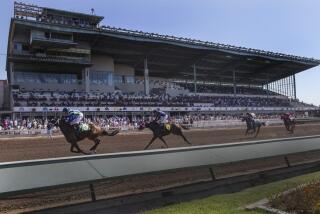HORSE RACING LOS ALAMITOS : A Family Business Pays Off for Silva
Racing horses, to fans, means taking chances. And, for those most intimately involved, it also requires love.
Mark Silva, who calls Buena Park home when standardbred racing is “in season” at Los Alamitos, has taken more than his share of risk over the past decade. His love of horses kept him going, and has seen him through.
The 26-year-old driver and trainer boasts one of the highest Universal Driver Rating System (UDRS) percentages at the current Los Alamitos session, and has done it with only a modestly-talented string of horses pampered and cared for by Silva, his mother and wife. It’s a family affair all right--and a recipe for success.
The UDRS measures efficiency, and the only driver Silva chases two-thirds through the Los Alamitos stand is Ross Croghan, who had the nation’s second-highest UDR at the conclusion of 1989.
Percentages, although not appearing in top 10 standings, are listed next to each driver and trainer in the past performance lines appearing in the nightly program.
“I’ve always had a high percentage,” Silva says. “All it takes, in my opinion, is hard work and classifying your horses right. If you do that, you’ll get your share of the breaks and your share of the money.”
Silva bested Croghan two years ago in Sacramento for the meeting’s top UDR. He did so with 10 horses, none of whom cost more than $6,000.
Currently, he campaigns a dozen pacers and trotters at Los Alamitos. None are stars, but the trotter Arnold’s World may be on the verge of invading invitational territory after a 1:59 4/5 tally February 24.
Love of horses began at an early age for the Canoga Park native. His father ran a trucking business, and dabbled in the sulky game. Young Silva was introduced to a jog cart and began exercising pacers and trotters around a half-mile track that surrounded his father’s truckyard.
He was seven years old.
Talk about an accelerated program. Mark successfully tested for his training and qualifying driver’s license on his 16th birthday. Six months later, he earned his “P” license--now a provisional driver, he was fully accredited to compete throughout North America.
While still in his teens, Silva began a somewhat nomadic existence required by the fact harness racing was not a year-around concern in California. He’d race in the Golden State over the summer and fall, but packed up each winter and competed at Fairmount Park, Illinois.
“It’s the closest track for us in the U.S.,” he says ruefully. “And I’d say it’s 2,000 miles away.”
But the moving made sound business sense. California-based stock was worth more at Fairmount Park, so they not only earned their way on the track but often were claimed--bought out of a race--for more than what Silva originally paid for them.
“I’d take 12 or 15 horses back there,” he says. “And come back with two or three. So I had to start all over.”
Typically during the troubled 1980s, claiming harness horses was a lost aspect of California racing. Silva, however, was unusually active, replenishing his barn in hopesthe new stock would compete for better purses in tne Midwest. High win and in-the-money percentages were the norm, and Silva would inevitably come back to California cash rich and horse poor.
“It made me a living,” he says of those years going back and forth. “But I’d like to stay here. This is home, and racing back there in winter can be brutal. It’s cold, and the tracks sometimes are too hard for the horses, so their feet sting.”
The continued decline in sulky racing locally the past couple years led Silva to abandon his strategy. “Horses that you bought for $5,000 a few years earlier could race against $8,000 horses at Fairmount Park,” he said. “But it got to where $5,000 horses here couldonly race against $5,000 horses back there. You know what I mean?”
With the traveling avenue closed, Silva, an experienced horsemen all of 2O-something years of age, was ready to give up the sport entirely.
But the purchase of Los Alamitos last fall by a group headed by longtime harness promoter Lloyd Arnold has revived the patient. Spirits are high, and horses are being claimedat nearly a rate of one per night, a sure sign of a bullish attitude.
Silva, who owns half interest in his current racing stock, prefers to remain cautiously optimistic.
“I have great (co-)owners,” he says. “And they are willing to spend more money than before and try to get some really good horses. But I want to see how things go for awhile.”
Also unlikely to change in the immediate future is the Silva approach to backstretch duties. “We’re there from about 7:30 in the morning until 3 p.m., then come back around 6 o’clock. If we have horses in late races, we may be there until 2 in the morning.”
His mother Jane, and Tammy, his wife of 15 months, bathe, rub and groom the horses. “And my Dad comes by each morning to check on things, too,” Silva says.
All the family support, along with Silva’s own driving and training skill, have enabled the Southern California native to post percentage and efficiency numbers realized by very few in his profession.
More to Read
Go beyond the scoreboard
Get the latest on L.A.'s teams in the daily Sports Report newsletter.
You may occasionally receive promotional content from the Los Angeles Times.










